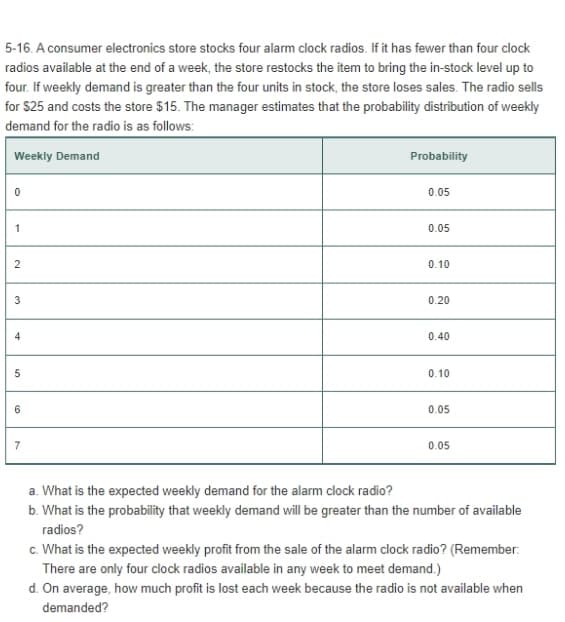5-16. A consumer electronics store stocks four alarm clock radios. If it has fewer than four clock radios available at the end of a week, the store restocks the item to bring the in-stock level up to four. If weekly demand is greater than the four units in stock, the store loses sales. The radio sells for $25 and costs the store $15. The manager estimates that the probability distribution of weekly demand for the radio is as follows: Weekly Demand Probability 0.05 0.05 2 0.10 0.20 1.
5-16. A consumer electronics store stocks four alarm clock radios. If it has fewer than four clock radios available at the end of a week, the store restocks the item to bring the in-stock level up to four. If weekly demand is greater than the four units in stock, the store loses sales. The radio sells for $25 and costs the store $15. The manager estimates that the probability distribution of weekly demand for the radio is as follows: Weekly Demand Probability 0.05 0.05 2 0.10 0.20 1.
Managerial Economics: A Problem Solving Approach
5th Edition
ISBN:9781337106665
Author:Luke M. Froeb, Brian T. McCann, Michael R. Ward, Mike Shor
Publisher:Luke M. Froeb, Brian T. McCann, Michael R. Ward, Mike Shor
Chapter17: Making Decisions With Uncertainty
Section: Chapter Questions
Problem 2MC
Related questions
Question
2

Transcribed Image Text:5-16. A consumer electronics store stocks four alarm clock radios. If it has fewer than four clock
radios available at the end of a week, the store restocks the item to bring the in-stock level up to
four. If weekly demand is greater than the four units in stock, the store loses sales. The radio sells
for $25 and costs the store $15. The manager estimates that the probability distribution of weekly
demand for the radio is as follows:
Weekly Demand
Probability
0.05
1
0.05
2
0.10
0.20
4
0.40
0.10
6.
0.05
0.05
a. What is the expected weekly demand for the alarm clock radio?
b. What is the probability that weekly demand will be greater than the number of available
radios?
c. What is the expected weekly profit from the sale of the alarm clock radio? (Remember:
There are only four clock radios available in any week to meet demand.)
d. On average, how much profit is lost each week because the radio is not available when
demanded?
Expert Solution
This question has been solved!
Explore an expertly crafted, step-by-step solution for a thorough understanding of key concepts.
This is a popular solution!
Trending now
This is a popular solution!
Step by step
Solved in 2 steps with 2 images

Knowledge Booster
Learn more about
Need a deep-dive on the concept behind this application? Look no further. Learn more about this topic, economics and related others by exploring similar questions and additional content below.Recommended textbooks for you

Managerial Economics: A Problem Solving Approach
Economics
ISBN:
9781337106665
Author:
Luke M. Froeb, Brian T. McCann, Michael R. Ward, Mike Shor
Publisher:
Cengage Learning

Managerial Economics: A Problem Solving Approach
Economics
ISBN:
9781337106665
Author:
Luke M. Froeb, Brian T. McCann, Michael R. Ward, Mike Shor
Publisher:
Cengage Learning